Here's another answer because, while I understood how the function subtype rules made sense, I wanted to work through why any other combination of argument/result subtyping did not.
The subtype rule is:

Meaning that if the top subtype conditions are met, then the bottom holds true.
In the function type definition, the function arguments are contravariant, since we've reversed the subtype relation between T1 and S1. The function results are covariant because they preserve the subtype relation between T2 and S2.
With the definition out of the way, why is the rule like this? It's well stated in Aaron Fi's answer, and I also found the definition here (search for the heading "Function Types"):
An alternative view is that it is safe to allow a function of one type
S1 → S2 to be used in a context where another type T1 → T2 is expected
as long as none of the arguments that may be passed to the function in this context will surprise it (T1 <: S1) and none of the results that it returns will surprise the context (S2 <: T2).
Again, that made sense to me, but I wanted to see why no other combination of typing rules made sense. To do this I looked at a simple higher order function and some example record types.
For all examples below, let:
S1 := {x, y}T1 := {x, y, z}T2 := {a}S2 := {a, b}
Example with contravariant argument types and covariant return types
Let:
f1 have type S1 → S2 ⟹ {x, y} → {a, b}f2 have type T1 → T2 ⟹ {x, y, z} → {a}
Now assume that type(f1) <: type(f2). We know this from the rule above, but let's pretend we don't and just see why it makes sense.
We run map( f2 : {x, y, z} → {a}, L : [ {x, y, z} ] ) : [ {a} ]
If we replace f2 with f1 we get:
map( f1 : {x, y} → {a, b}, L : [ {x, y, z} ] ) : [ {a, b} ]
This works out fine because:
- Whatever the function
f1 does with its argument, it can ignore the extra z record field and have no problems.
- Whatever the context running
map does with the results, it can ignore
the extra b record field and have no problems.
Concluding:
{x, y} → {a, b} ⟹ {x, y, z} → {a} ✔
Example with covariant argument types and covariant return types
Let:
f1 have type T1 → S2 ⟹ {x, y, z} → {a, b}f2 have type S1 → T2 ⟹ {x, y} → {a}
Assume type(f1) <: type(f2)
We run map( f2 : {x, y} → {a}, L : [ {x, y} ] ) : [ {a} ]
If we replace f2 with f1 we get:
map( f1 : {x, y, z} → {a, b}, L : [ {x, y} ] ) : [ {a, b} ]
We can run into a problem here because f1 expects and might operate on the z record field, and such a field is not present in any records in list L. ⚡
Example with contravariant argument types and contravariant return types
Let:
f1 have type S1 → T2 ⟹ {x, y} → {a}f2 have type T1 → S2 ⟹ {x, y, z} → {a, b}
Assume type(f1) <: type(f2)
We run map( f2 : {x, y, z} → {a, b}, L : [ {x, y, z} ] ) : [ {a, b} ]
If we replace f2 with f1 we get:
map( f1 : {x, y} → {a}, L : [ {x, y, z} ] ) : [ {a} ]
We have no issue with ignoring the z record field when passed into f1, but if the context that calls map expects the a list of records with a b field, we will hit an error. ⚡
Example with covariant argument types and contravariant return
Look at the above examples for the two places this could go wrong.
Conclusion
This is a very long and verbose answer, but I had to jot this stuff down to figure out why other argument and return parameter subtyping was invalid. Since I had it somewhat written down, I figured why not post it here.


